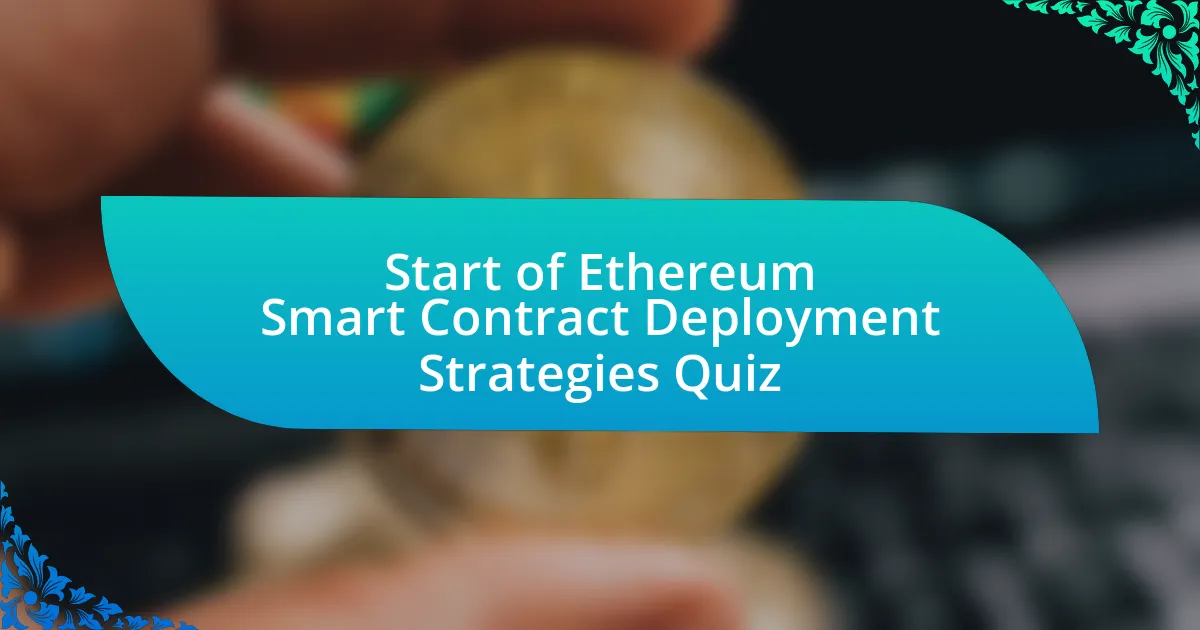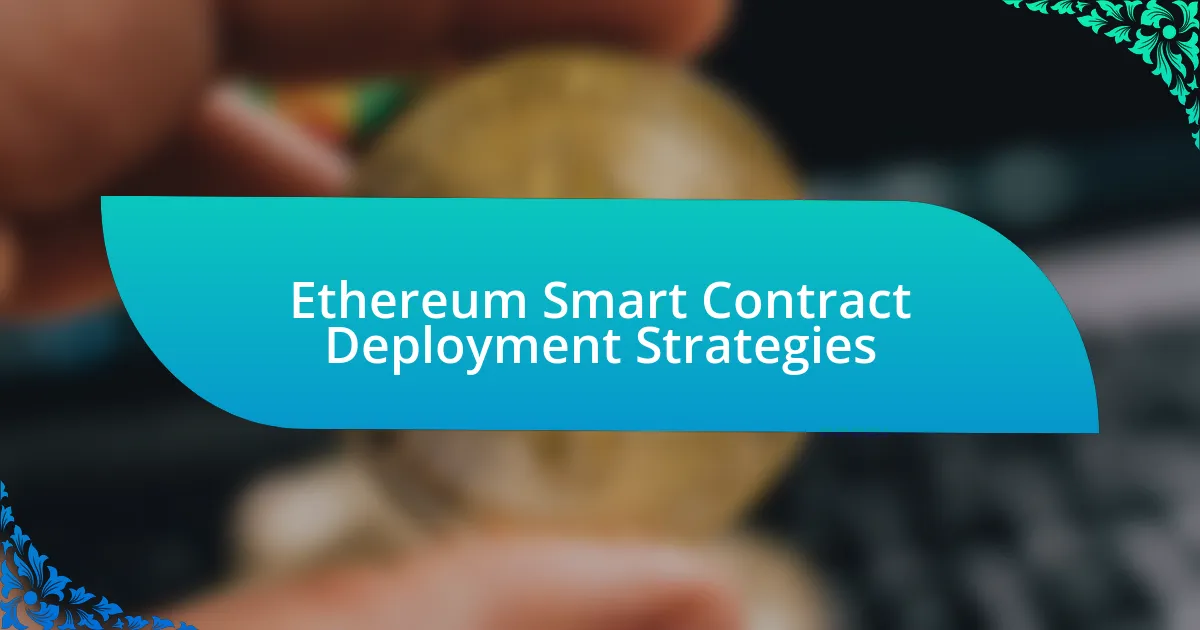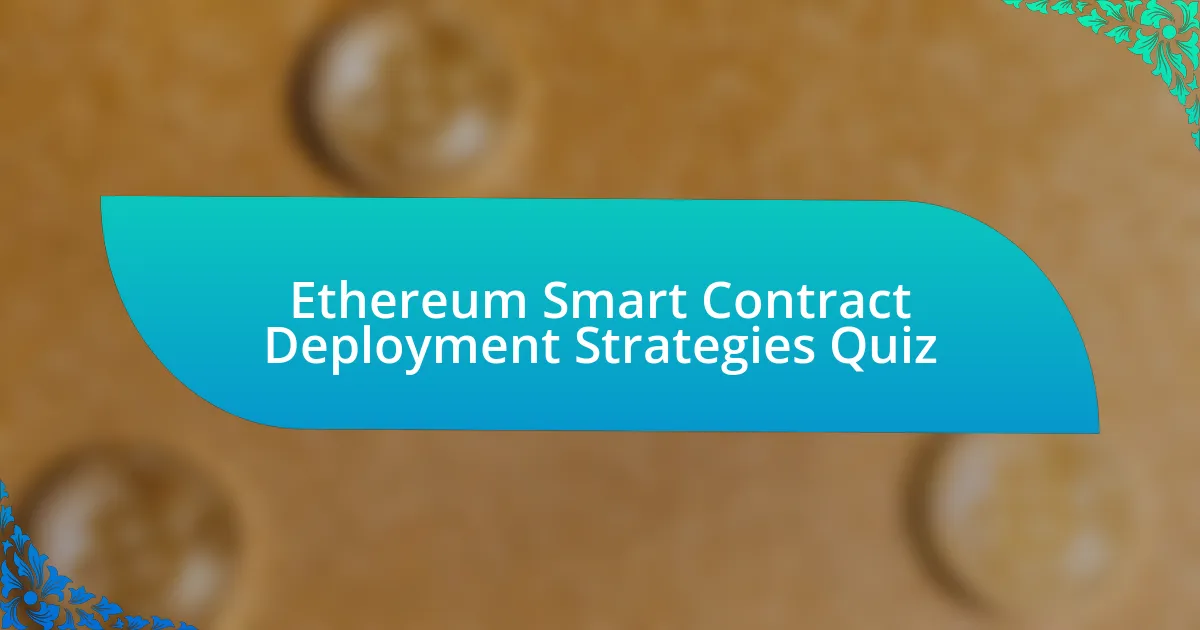
Start of Ethereum Smart Contract Deployment Strategies Quiz
1. What is the primary method of interacting with smart contracts on Ethereum?
- Writing directly in Solidity
- Sending physical mail
- Interacting via FTP protocol
- Using a wallet interface
2. What type of testing is essential before deploying a smart contract to the mainnet?
- Performance testing
- Load testing
- Integration testing
- Unit testing
3. What does the Ethereum Virtual Machine (EVM) do during smart contract execution?
- Validates user identities before allowing transactions.
- Collects fees for transactions and services on the network.
- Provides user interface for interacting with contracts.
- Executes code of smart contracts by managing input and state changes.
4. What is a smart contract upgradeability pattern?
- Proxy pattern
- Singleton pattern
- Factory method
- Observer pattern
5. How can you optimize gas costs during the deployment of a smart contract?
- Optimize and minimize the smart contract code for efficiency.
- Deploy contracts on a private network to save costs.
- Increase the gas limit to accommodate large contracts.
- Use more expensive operations for better performance.
6. What are events in the context of smart contracts, and why are they important?
- Events are mechanisms to execute arbitrary code within smart contracts.
- Events are specific types of smart contracts that handle payments.
- Events are external APIs that interact with smart contracts for data retrieval.
- Events are logs that smart contracts generate during execution, allowing applications to listen for important state changes.
7. What strategy can be used to limit the exposure of a smart contract to potential attacks?
- Implementing access controls and limiting function visibility.
- Using a more complex programming language.
- Increasing the number of transactions per second.
- Downloading random smart contracts from the internet.
8. How does a `multisig` wallet enhance security in Ethereum applications?
- A multisig wallet allows unlimited transactions without restrictions.
- A multisig wallet uses a single key to control funds.
- A multisig wallet requires multiple signatures for transactions, enhancing security.
- A multisig wallet is only for storing ERC20 tokens.
9. What is the significance of the `constructor` in a smart contract?
- The constructor initializes the contract state and sets parameters.
- The constructor defines the financial transactions in the contract.
- The constructor is used for error handling during execution.
- The constructor is primarily for debugging purposes in smart contracts.
10. How can developers ensure that their smart contracts are free from common vulnerabilities like reentrancy?
- Use unverified third-party libraries.
- Implement randomness in the contract.
- Deploy without testing.
- Use the Checks-Effects-Interactions pattern.
11. What is the purpose of the `fallback function` in a smart contract?
- The fallback function executes all functions within the contract automatically.
- The fallback function allows a smart contract to receive Ether and handle calls without matching function signatures.
- The fallback function prevents unauthorized access to the contract.
- The fallback function stores user data for later retrieval.
12. How can Solidity libraries improve smart contract development efficiency?
- Solidity libraries make contracts less flexible and harder to maintain.
- Solidity libraries promote code reuse and modularity, leading to reduced development time.
- Solidity libraries are used for encryption and security but do not enhance development efficiency.
- Solidity libraries only add complexity without any advantages in efficiency.
13. What technique allows contract state changes to be reversible?
- Snapshots
- Ignoring
- Checkpointing
- Hardcoding
14. Why is monitoring transaction performance important after deploying a smart contract?
- It helps identify issues and optimizations for efficient use of resources.
- It allows users to vote on contract changes directly.
- It prevents unauthorized access to the smart contract.
- It ensures the contract adheres to legal regulations.
15. What role do oracles play in making smart contracts more functional?
- Oracles handle the storage of smart contracts on the blockchain.
- Oracles provide real-world data to smart contracts, enabling them to execute based on external conditions.
- Oracles are responsible for the user interface of decentralized applications.
- Oracles create new cryptocurrencies for smart contracts to use.
16. How can static analysis tools contribute to a smart contract`s security?
- They can ensure the contract will always generate profit.
- They can create more complex smart contract functions.
- They can identify vulnerabilities and security flaws in the code.
- They can increase the gas fees required for deployment.
17. What are the benefits of using a framework like Brownie for Ethereum development?
- Increased storage capacity for user data.
- Simplified database management for Web2 applications.
- Automation of deployment process and configuration management.
- Enhanced graphics for front-end applications.
18. In what scenarios is using an upgradeable proxy contract advisable?
- When the contract is deployed on a private network only.
- When the contract has a fixed purpose and will not change.
- When all developers agree to never modify the contract.
- When the contract logic needs to be updated without losing state.
19. How can integrating with IPFS enhance smart contract capabilities?
- It increases the execution speed of smart contracts significantly.
- It makes smart contracts entirely decentralized without any blockchain.
- It allows storage of large data off-chain while maintaining integrity with hashes.
- It replaces Ethereum`s gas fees with IPFS transaction fees.
20. What factors should be considered when selecting an Ethereum network for deployment?
- The weather conditions on the deployment day, programming language used, geographic location of team members, and user interface design.
- The color scheme of the application, number of followers on social media, marketing strategies, and seasonal sales data.
- Popularity of the blockchain among social media influencers, the latest fashion trends, celebrity endorsements, and government regulations on art.
- The availability of required infrastructure, transaction costs, network security, and scalability.
21. What is the role of a dev environment when testing smart contracts?
- The dev environment automatically deploys contracts to the main blockchain.
- The dev environment allows for thorough testing and debugging of smart contracts before deployment.
- The dev environment stores all transaction data permanently.
- The dev environment serves as a live trading platform for smart contracts.
22. How can you implement a time lock in a smart contract?
- Implement a random number generator for time validation
- Utilize a transaction hash for time-based access control
- Use a block timestamp to restrict access until a specified time
- Set a fixed gas limit to control execution timing
23. Why is it essential to verify smart contract source code after deployment?
- It ensures that all users must pay for using the contract.
- It provides a way to change the contract`s code after deployment.
- It guarantees the contract generates more profits for the owner.
- It confirms the contract`s correctness and security after deployment.
24. What are the implications of inadvertently leaving a contract self-destruct function callable?
- It makes the contract faster and more efficient overall.
- It ensures the contract executes well, preventing failure.
- It can cause unintended execution of critical functions, resulting in financial loss.
- It protects all data stored within the contract from external access.
25. How does proper error handling contribute to a smart contract`s robustness?
- Proper error handling adds unnecessary complexity and increases costs.
- Proper error handling prevents unexpected behavior and vulnerabilities.
- Proper error handling guarantees profitability and success in every transaction.
- Proper error handling is irrelevant as all smart contracts run perfectly.
26. What is the significance of gas estimation before deploying a contract?
- It helps estimate the cost of deploying the contract to ensure sufficient funds are available.
- It determines the contract`s maximum gas limit for execution on the network.
- It assesses the security vulnerabilities before finalizing the contract`s code.
- It calculates the time it will take to deploy the contract and execute its functions.
27. How can using a test framework like Mocha for Solidity code simplify testing?
- It eliminates the need for any coding knowledge when testing.
- It prevents all bugs from appearing in the code during testing.
- It automates repetitive testing processes, making them easier to manage.
- It generates perfect smart contracts without user input.
28. In what ways can composability benefit smart contracts in Ethereum?
- Composability eliminates the need for gas fees in contract transactions.
- Composability restricts interactions to a single contract only, simplifying functionalities.
- Composability increases the execution time of smart contracts, leading to inefficiencies.
- Composability allows different contracts to interact and build on each other, enabling more complex functionalities.
29. What is the preferred method for managing contract upgrades?
- Ignoring the upgrade process
- Re-deploying existing contracts
- Writing new contracts each time
- Use upgradeable contracts
30. How can developers ensure that smart contracts interact correctly with existing protocols?
- Conduct thorough testing with existing protocols.
- Ignore compatibility assessments with other protocols.
- Rely solely on community feedback before deployment.
- Use only manual code reviews without external tools.

Congratulations! You’ve Completed the Quiz!
Thank you for taking the time to complete the quiz on Ethereum Smart Contract Deployment Strategies. This journey has highlighted important concepts and techniques that empower developers to deploy smart contracts efficiently. You may have discovered the intricacies of gas optimization, deployment platforms, and best practices that enhance smart contract performance.
As you reflect on your answers, think about the key lessons learned. Understanding how to choose the right deployment strategy can significantly impact the success of your Ethereum projects. This knowledge can help you make informed decisions when launching your own smart contracts, ensuring they run smoothly and cost-effectively.
For those eager to dive deeper into the subject, we invite you to explore the next section on this page. It contains a wealth of information about Ethereum Smart Contract Deployment Strategies that will expand your understanding and help you master these crucial skills. Happy learning!

Ethereum Smart Contract Deployment Strategies
Overview of Ethereum Smart Contracts
Ethereum smart contracts are self-executing contracts with the terms of the agreement written into code. They run on the Ethereum blockchain, ensuring transparency and security. Once deployed, they execute automatically when predefined conditions are met. Their decentralized nature eliminates the need for intermediaries, reducing costs and increasing efficiency in various transactions.
Smart Contract Deployment Process
The smart contract deployment process involves several key steps. First, developers write the contract code using the Solidity programming language. Next, the code is tested in a development environment, such as Remix or Truffle. After testing, the contract is compiled and deployed to the Ethereum network. This deployment requires a transaction fee, known as gas, which covers the cost of executing the contract on the blockchain.
Strategies for Optimizing Gas Costs
One critical aspect of deploying smart contracts is optimizing gas costs. Developers can implement several strategies to achieve cost efficiency. These include minimizing contract size, using efficient data structures, and avoiding complex logic. Additionally, developers can choose to deploy during times of lower network congestion, which can significantly reduce gas fees. Each strategy contributes to overall cost-effectiveness in deploying a smart contract.
Selecting the Right Ethereum Network
Choosing the appropriate Ethereum network is essential for successful deployment. Developers can opt for the mainnet or various testnets like Ropsten, Rinkeby, or Kovan. The mainnet is the primary network where real transactions occur, while testnets allow developers to test their contracts in a risk-free environment. Selecting a network depends on the stage of development, testing needs, and the intent to launch in a live scenario.
Post-Deployment Management and Upgradability
After deployment, managing a smart contract is crucial for its longevity and effectiveness. Developers must consider upgradability options to address potential bugs or changes in requirements. Proxy patterns and upgradable contract frameworks, such as OpenZeppelin, allow for safe updates without losing the original contract address. This approach ensures the contract can evolve while maintaining the integrity of existing interactions.
What are Ethereum smart contract deployment strategies?
Ethereum smart contract deployment strategies refer to the various methods and practices for successfully deploying smart contracts onto the Ethereum blockchain. These strategies include optimizing contracts for gas efficiency, using development frameworks like Truffle or Hardhat, and employing multi-signature wallets for security. For effective deployment, developers often choose between public testing on test networks, such as Ropsten or Rinkeby, and mainnet deployment, which ensures the contract is operational and immutable. A study by ConsenSys highlights that approximately 55% of Ethereum contracts are deployed using automation tools that enhance deployment reliability.
How do developers deploy Ethereum smart contracts?
Developers deploy Ethereum smart contracts primarily using development environments like Truffle or Hardhat. They write the contract code in Solidity, compile it, and then deploy it through Ethereum nodes or wallets using web3.js or ethers.js libraries. The deployment process involves sending a transaction to the Ethereum network with the compiled bytecode of the contract, which then verifies and stores it on the blockchain. According to the Ethereum Foundation’s documentation, deploying a contract typically incurs gas fees, which depend on the complexity of the contract code and current network conditions.
Where can Ethereum smart contracts be deployed?
Ethereum smart contracts can be deployed on the Ethereum mainnet or several Ethereum testnets such as Ropsten, Rinkeby, and Goerli. Testnets serve as platforms for developers to test their contracts without the risk of losing real funds. Deployments to the mainnet are final and must be handled with care, as contracts become immutable once confirmed. Statistics show that over 80% of smart contracts are initially deployed on testnets before migrating to the mainnet for production use.
When should developers deploy Ethereum smart contracts?
Developers should deploy Ethereum smart contracts after thorough testing and audit processes. Generally, the best practice is to deploy on testnets first to validate functionality and security. Once the contract is fully tested and optimized, a deployment on the mainnet can follow. Industry reports indicate that over 30% of failed deployments result from insufficient testing, underlining the importance of readiness before mainnet deployment.
Who is responsible for deploying Ethereum smart contracts?
The responsibility for deploying Ethereum smart contracts typically falls to blockchain developers or smart contract engineers. These professionals manage writing, testing, and deploying contracts. In many cases, teams or organizations may designate a lead developer to oversee the deployment process, ensuring best practices are followed. According to a survey by GitHub, about 70% of smart contract developers work in teams, indicating a collaborative approach to deployment.

